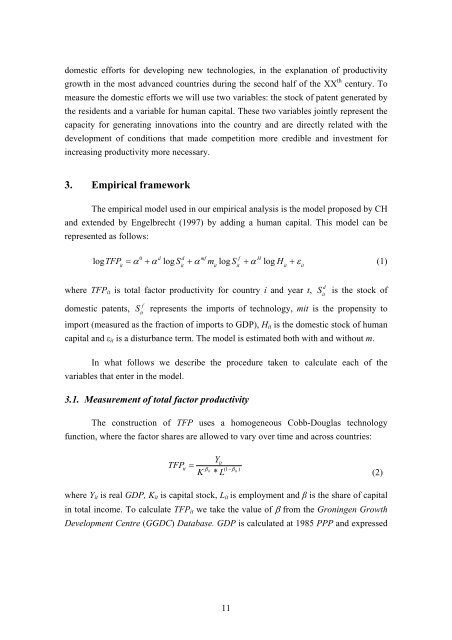You also want an ePaper? Increase the reach of your titles
YUMPU automatically turns print PDFs into web optimized ePapers that Google loves.
domestic efforts for developing new technologies, in the explanation of productivity<br />
growth in the most advanced countries during the second half of the XX th century. To<br />
measure the domestic efforts we will use two variables: the stock of patent generated by<br />
the residents and a variable for human capital. These two variables jointly represent the<br />
capacity for generating innovations into the country and are directly related with the<br />
development of conditions that made competition more credible and investment for<br />
increasing productivity more necessary.<br />
3. Empirical framework<br />
The empirical model used in our empirical analysis is the model proposed by CH<br />
and extended by Engelbrecht (1997) by adding a human capital. This model can be<br />
represented as follows:<br />
logTFP it<br />
= α 0 + α d log S it d + α mf m it<br />
log S it<br />
f<br />
+ α H log H it<br />
+ ε it<br />
(1)<br />
where TFP it is total factor productivity for country i and year t, S it<br />
d<br />
is the stock of<br />
f<br />
domestic patents, S it<br />
represents the imports of technology, mit is the propensity to<br />
import (measured as the fraction of imports to GDP), H it is the domestic stock of human<br />
capital and ε it is a disturbance term. The model is estimated both with and without m.<br />
In what follows we describe the procedure taken to calculate each of the<br />
variables that enter in the model.<br />
3.1. Measurement of total factor productivity<br />
The construction of TFP uses a homogeneous Cobb-Douglas technology<br />
function, where the factor shares are allowed to vary over time and across countries:<br />
TFP<br />
it<br />
=<br />
K<br />
β<br />
it<br />
Y<br />
it<br />
(1−<br />
β )<br />
it<br />
* L<br />
(2)<br />
where Y it is real GDP, K it is capital stock, L it is employment and β is the share of capital<br />
in total income. To calculate TFP it we take the value of β from the Groningen Growth<br />
Development Centre (GGDC) Database. GDP is calculated at 1985 PPP and expressed<br />
11

















